
Agra, town of the Legendary Taj Mahal
From 1556 to 1658, Agra was the capital of the Mughal Empire. Today it is best known for the Taj Mahal, one of the world’s most famous monuments and now a kind of emblem of India. With no fewer than 10,000 visits per day, the Taj Mahal seems to enjoy a prestige like no other place in India, probably because of the romantic legend of its origins. As well as the famous Taj Mahal, the Mughal emperors left Agra a rich architectural heritage that attracts millions of tourists every year.
The city of Agra was founded in 1501-1504 by Sikandar Lodi, Sultan of Delhi, who made it his capital. In 1526 Babur, the first Mughal emperor, defeated the Delhi sultanate and seized Agra. His grandson restored the town to its status as capital in 1556.
The city’s heyday ran from the mid-16th century to the mid-17th, under the successive reigns of Akbar, Jahangir and Shah Jahan. It was Shah Jahan who had the Taj Mahal built in 1631, before he transferred the capital of the empire to Delhi.
Festivals not to miss
 Taj Mahotsav: Taj Mahotsav is celebrated at Shilpgram near the Eastern gate of “Taj Mahal”. This 10 days long carnival is actually a vibrant platform that gives you information of India where you can find India’s rich arts, crafts, cultures, cuisine, dance and music.Taj Mahotsav is organized by UP Tourism and it is a source to increase Indian Tourism.
Taj Mahotsav: Taj Mahotsav is celebrated at Shilpgram near the Eastern gate of “Taj Mahal”. This 10 days long carnival is actually a vibrant platform that gives you information of India where you can find India’s rich arts, crafts, cultures, cuisine, dance and music.Taj Mahotsav is organized by UP Tourism and it is a source to increase Indian Tourism.
 Kailash Fair: Organized at Kailash temple in Agra, (12km from Agra) in the honor of Lord Shiva, Kailash fair is celebrated to memorialize the appearance of Lord Shiva in the form of a stone lingam here in the monsoon months of August and September.The followers of this god of the Hindu pantheon memorize his visit, offer prayers to him and contribute in all the fun and amusement of the fair.
Kailash Fair: Organized at Kailash temple in Agra, (12km from Agra) in the honor of Lord Shiva, Kailash fair is celebrated to memorialize the appearance of Lord Shiva in the form of a stone lingam here in the monsoon months of August and September.The followers of this god of the Hindu pantheon memorize his visit, offer prayers to him and contribute in all the fun and amusement of the fair.
Follow the guide !
Taj Mahal
The Taj Mahal (the name is Iranian for “palace of the crown”) stands beside the river Yamuna.
It is a white marble mausoleum built by the Mughal emperor Shah Jahan in memory, it is said, of his favourite wife Arjumand Banu Begam, also known as Mumtaz Mahal. She died in 1631; the building of the mausoleum began the same year and was completed, for the most part, in 1643. Shah Jahan died in 1666 and his tomb stands alongside his wife’s.
The Taj Mahal is a World Heritage site and is considered a supreme example of Mughal architecture, which combines Iranian, Ottoman Turkish and Indian elements.
On either side of the mausoleum stands a sandstone building with three white marble domes.
The building on the left is a mosque, built to sanctify the place and provide pilgrims with a place of worship. The one on the right, called the Jawab (“reply”), is an exact symmetrical replica of the mosque; it was built for the sake of symmetry and not used as a mosque since it is not oriented towards Mecca.
The romantic tale of the Taj Mahal’s origin has been dismantled more than once.
According to some, it was built to demonstrate the emperor’s power rather than to house his favourite wife’s tomb. This is argued mainly from the character of Shah Jahan, who was by no means a sentimental type.
It took him 22 years and 22,000 workmen, treated as slaves, to build the Taj Mahal. Over the course of his life Shah Jahan is said to have kept no fewer than 2000 wives effectively imprisoned in his harem, and Arjumand Banu Begam, the favourite buried in the Taj Mahal, died from bearing too many children (14 of them). He certainly doesn’t sound like a romantic.
Another theory, put forward by Purushottam Nagesh Oak, is that the site was a palace and Vedic temple to Shiva, called the Tejomahalay, before it was transformed into a mausoleum. This theory has not found favour with the scientific community.
Mehtab Bagh, Moonlight Garden
The Mehtab Bagh or “moonlight garden” was the last of 11 Mughal style gardens built along the Yamuna river opposite the Taj Mahal.
The first was the Ram Bagh, reportly built by the emperor Babur in 1530. Originally it was an extension to the Taj Mahal garden on the other side of the river. It was planted with scented flowers and used in the cool of evening to gaze at the reflection of the Taj Mahal in the river and in the octagonal pool built for that purpose.
The Mehtab Bagh was later lost under an accumulation of mud from successive floods; it was restored in the 1990s.
It is a popular place to admire the Taj Mahal at sunset.
Agra Fort
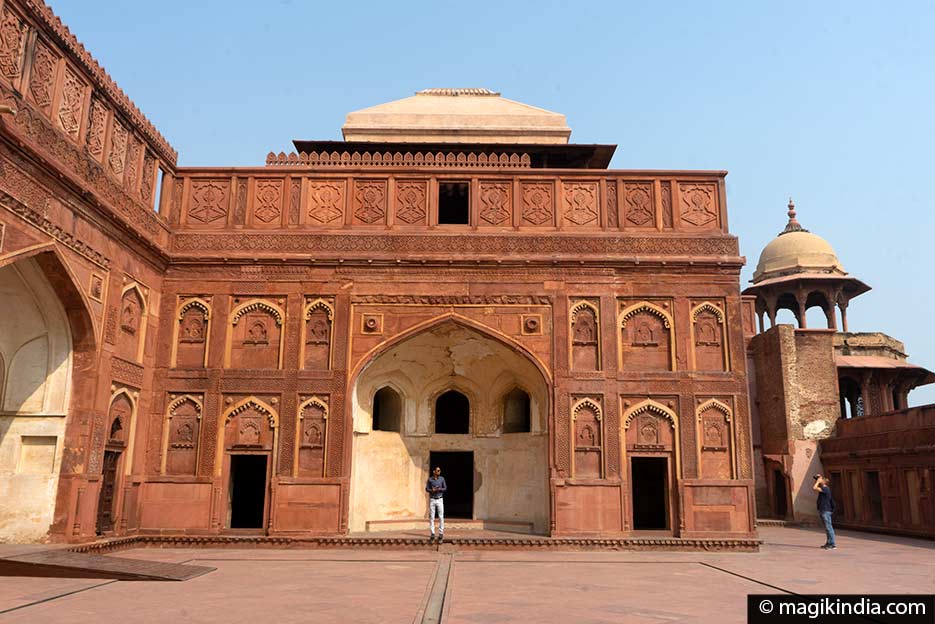
Near the gardens of the Taj Mahal stands an important 17th-century Mughal monument known as the Red Fort of Agra.
This powerful red sandstone fortress encloses the imperial city of the Mughal rulers in a 2.5km rampart wall. It includes numerous palaces such as Jahangir Palace and the Khas Mahal, built by Shah Jahan, as well as audience halls such as the Diwan-i-Khas and two very fine mosques.
The earliest mention of a fort here dates from 1080, when it was a simple brick fortress belonging to the Sikarwars, a Rajput clan from Rajasthan.
It was a military stronghold until Akbar transformed it into a place of residence and had a number of palaces built there. The architectural style was Hindu at first, the Mughal style superseding it later, under the reign of Shah Jahan.
Jama Masjid Mosque
The Jama Masjid or Friday mosque stands opposite the Red Fort. It was built in 1648 by Emperor Shah Jahan in honor of his eldest daughter, Jahanara Begum Sahiba. With its lotus-shaped domes with zigzag patterns alternating white marble and red sandstone and its fountain surmounted by four small kiosks, it reflects the elegance and finesse of Persian architecture.
Tomb of l’timad-ud-Daulah
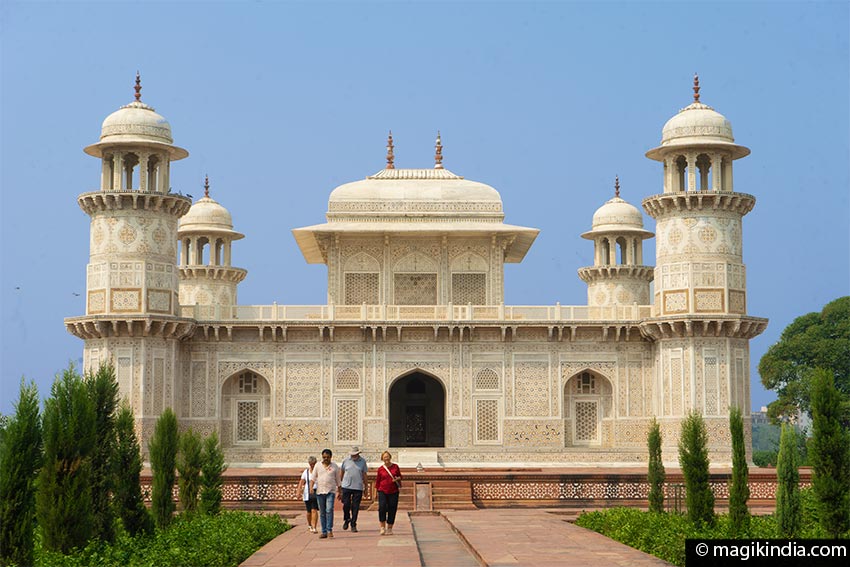
The tomb of I’timad-ud-Daulah is often regarded as a draft for the Taj Mahal. It is often described as a jewel-box or a “mini-Taj”. Its interior decor is indeed thought to have inspired that of the Taj Mahal.
The complex includes numerous outbuildings and gardens. The mausoleum was built between 1622 and 1628 on the orders of Nur Jahan, wife of Jahangir, for her father Mirza Ghiyas Beg who had been granted the title of I’timad-ud-Daula (“pillar of the state”).
Chini-ka-rauza Mausoleum (1km)
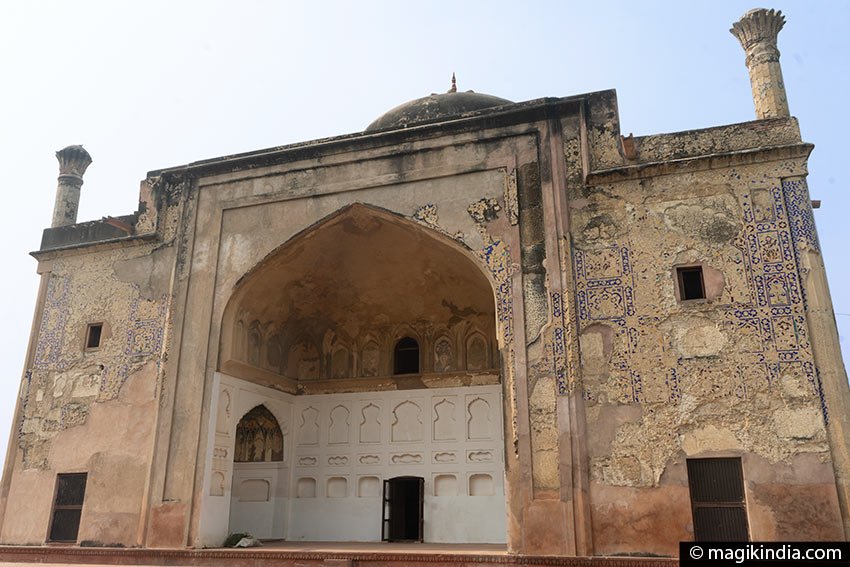
The Chini ka Rauza is a mausoleum housing the tomb of Allama Afzal Khan Mullah, a scholar and poet who was prime minister to the Mughal emperor Shah Jahan.
The tomb was built in 1635 and although it has not been as well preserved as the other monuments, one can still admire a beautiful ceiling encrusted with porcelain colored tiles, called Kashi or Chini in Afghan, after which it is named.
Akbar church (5km)
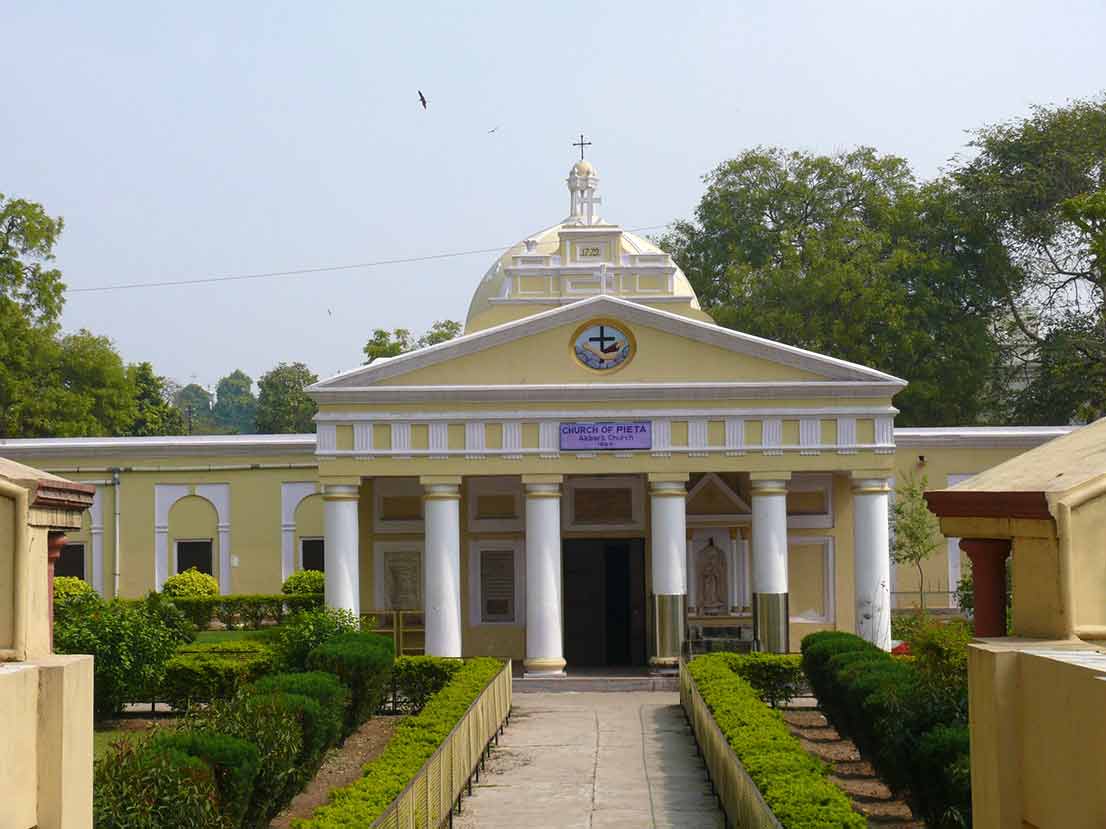 This church is a curiosity! Located 5 km west of the Taj Mahal, this Christian building have a Muslim name, that of the Mughal Emperor Akbar.
This church is a curiosity! Located 5 km west of the Taj Mahal, this Christian building have a Muslim name, that of the Mughal Emperor Akbar.
According to historical accounts, Akbar liked to debate different religions, and for this purpose, in 1950, he invited a delegation of three Portuguese Jesuit priests who made their way from Goa: Antoine de Monserrate, Rodolfe Aquauiua and François Henriques.
The emperor never converted to Christianity, however, the visit of these Jesuit brothers left their mark on the city and an Armenian Christian community was born. Later, Akbar granted land to this community and the Akbar church was built in 1560.
Emperor Shah Jahan, less tolerant, demolished the church in 1635, after capturing Jesuit priests who seemed to have crossed the religious boundaries of Islam. The church was rebuilt in 1636 after the pardon of the Jesuits.
Akbar’s Mausoleum (8km)
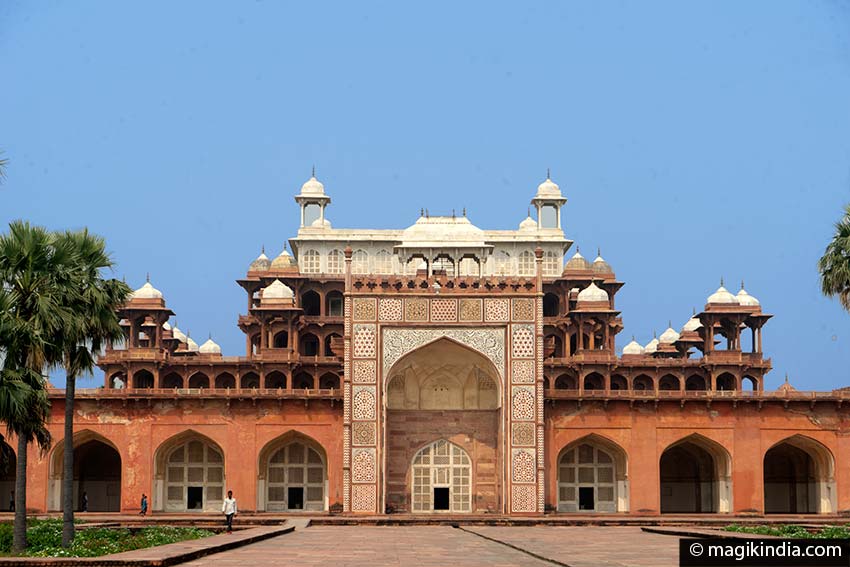
A monument not to be missed! The Akbar’s Mausoleum located in Sikandra, 8 km from Agra is a pure enchantment!
Akbar the Great (1555-1605), the third Mughal emperor, started building his mausoleum during his lifetime, in 1600. It was completed in 1613, after his death, by his son Jahangir. Akbar was one of the greatest emperors in the history of India.
It is built mainly of red sandstone and decorated with superb inlaid panels and surrounded by many gardens spread over nearly 50 hectares. A contemplative and historical place.
Mariam’s Tomb (8km)
Not far from the mausoleum of Akbar is the Mariam Mausoleum, an elegant monument in finely carved red sandstone that is worth a visit.
Mariam Zamani (Heer Kunwar) was the wife of the Mughal emperor Akbar the Great and daughter of King Bharmal Kachwaha of Amber. She died in Agra in 1623.
Huzur Swamiji Maharaja’s tomb (10km)

This white marble building in its huge garden is the Samadhi (i.e. tomb) of Huzur Swamiji Maharaja (Shri Shiv Dayal Singh Seth).
This intriguing cult is based on ethics and the fusion of the principles of Sikhism and Hinduism. But while inspired by these different religions, the Radhasoami faith differs from these in the sense that its followers reject the concept of sacred scriptures and rituals. They follow a spiritual teacher (guru) and organize satsangs (spiritual meetings) with him. They believe in social equality and prohibit caste distinctions.
This faith has been emulated beyond the borders of India and there are no less than 3 million followers around the world.
TO VISIT AROUND : Fatehpur Sikri (50km)
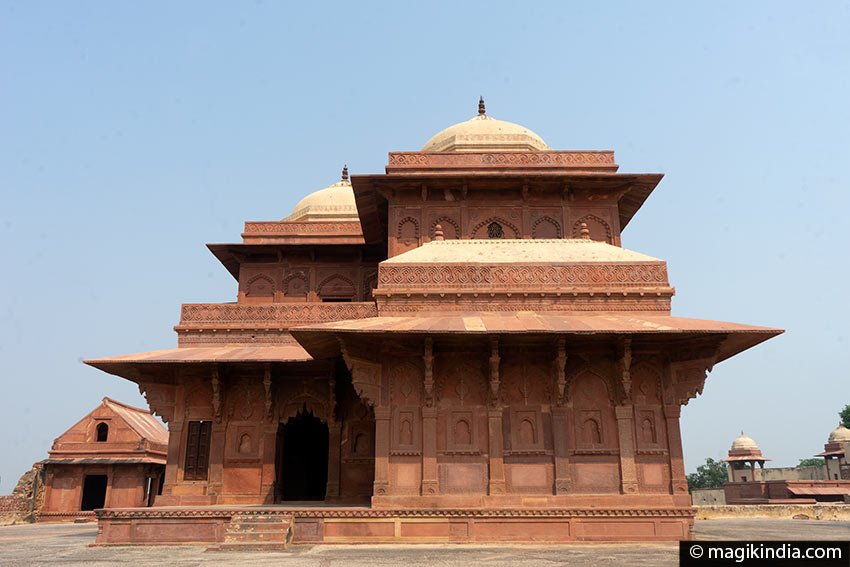 Fatehpur Sikri, the “City of Victory” 50km south of the Taj Mahal is a remarkable architectural complex. Especially notable is the huge Jama Masjid mosque. Apparently it was once as holy as the one in Mecca.
Fatehpur Sikri, the “City of Victory” 50km south of the Taj Mahal is a remarkable architectural complex. Especially notable is the huge Jama Masjid mosque. Apparently it was once as holy as the one in Mecca.
This complex, now listed as a World Heritage site, was founded in 1569 by the Mughal emperor Akbar. It briefly served as the capital of the Mughal Empire from 1571 to 1585, when it was abandoned in favour of Lahore.
Only a small part of the town survives today, but originally it possessed several mosques, numerous palaces, the homes of court members, and so on.
Fatehpur Sikri is one of the finest 16th-century Mughal architectural heritage sites and a fine example of the marriage of Hindu, Jain and Muslim architectural traditions that influenced so much of India’s urban architecture, as in Old Delhi particularly.
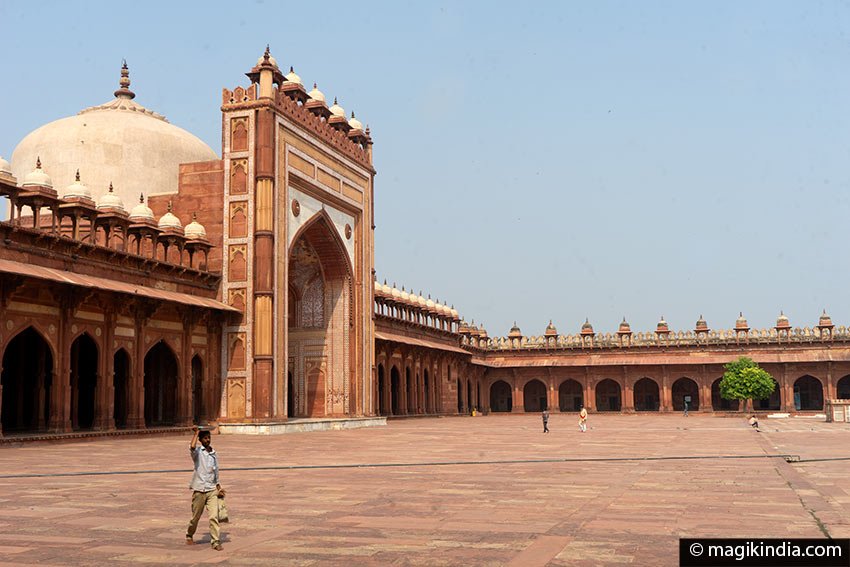 The Jama Masjid mosque, at 165m x 133m, is one of India’s largest mosques. It could accommodate 10,000 worshippers. It was completed in 1571-1572.
The Jama Masjid mosque, at 165m x 133m, is one of India’s largest mosques. It could accommodate 10,000 worshippers. It was completed in 1571-1572.

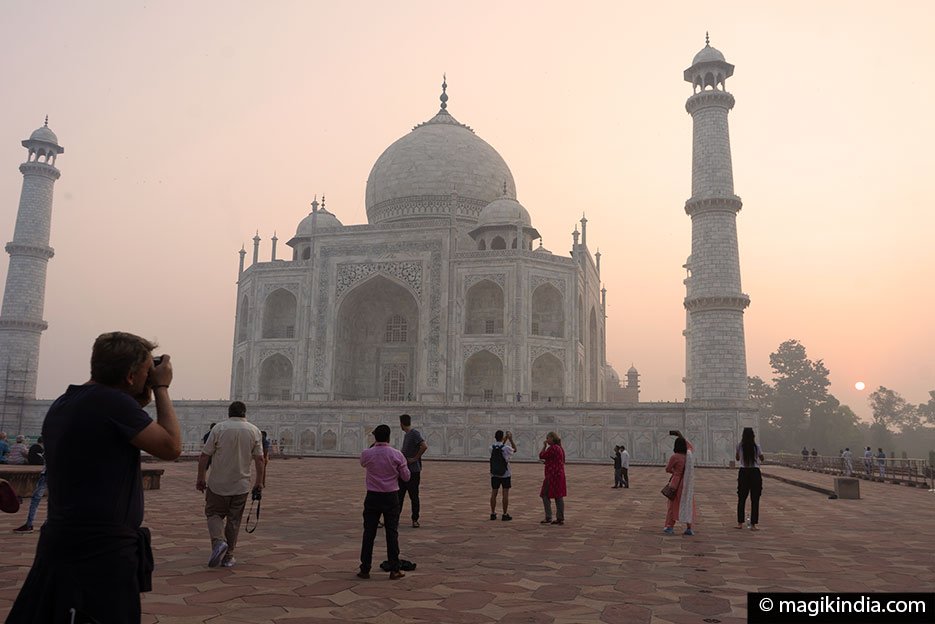
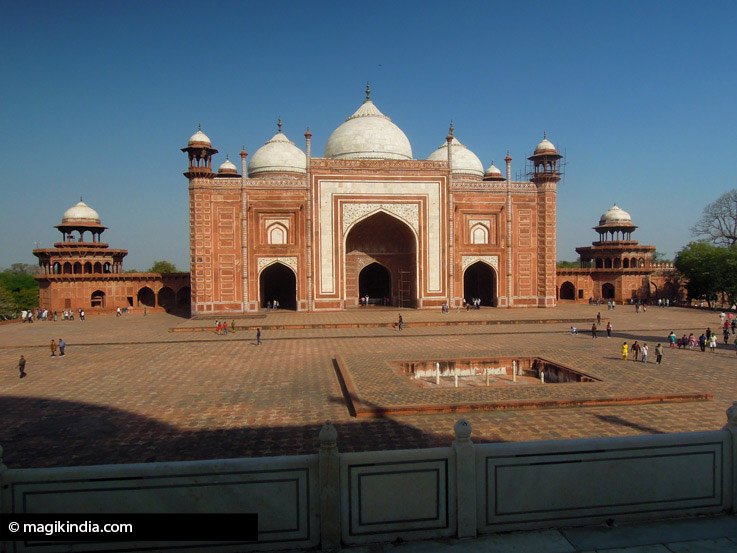
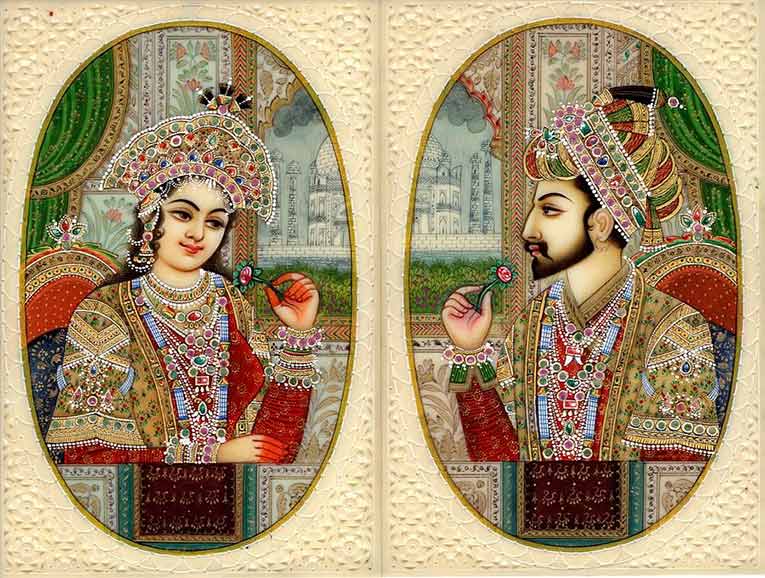
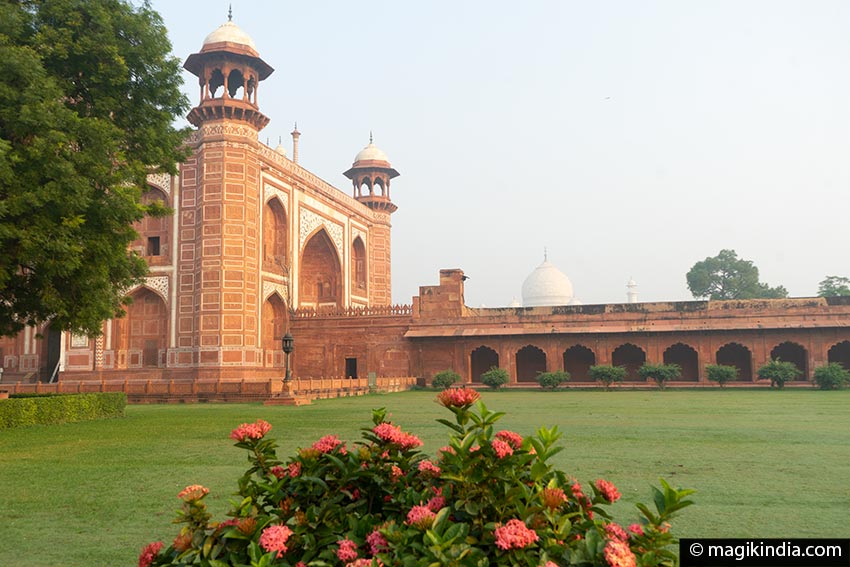
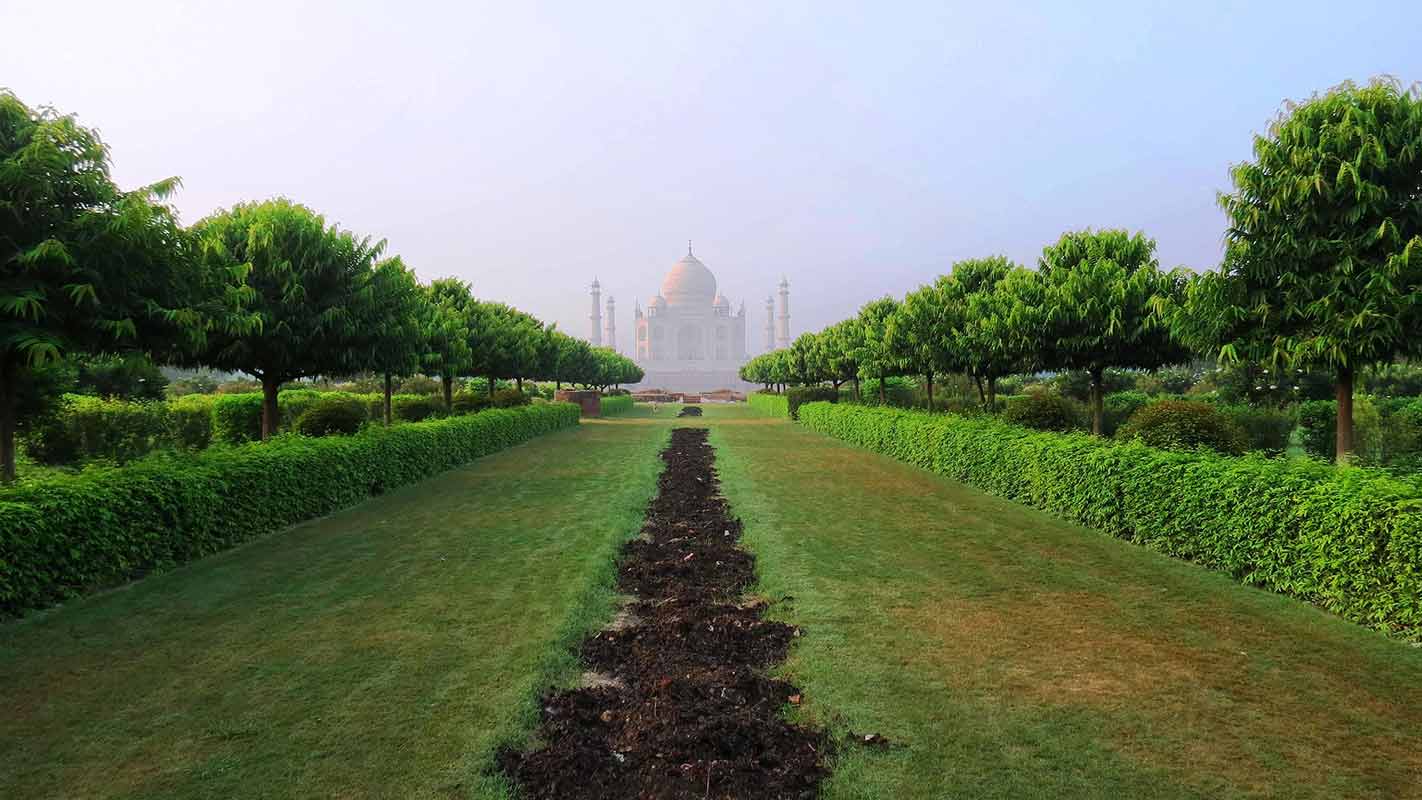
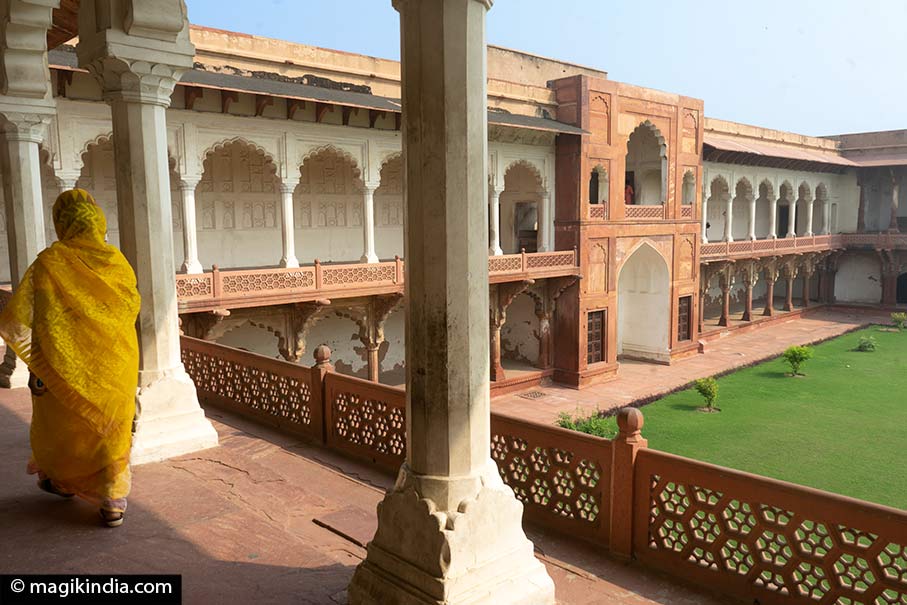


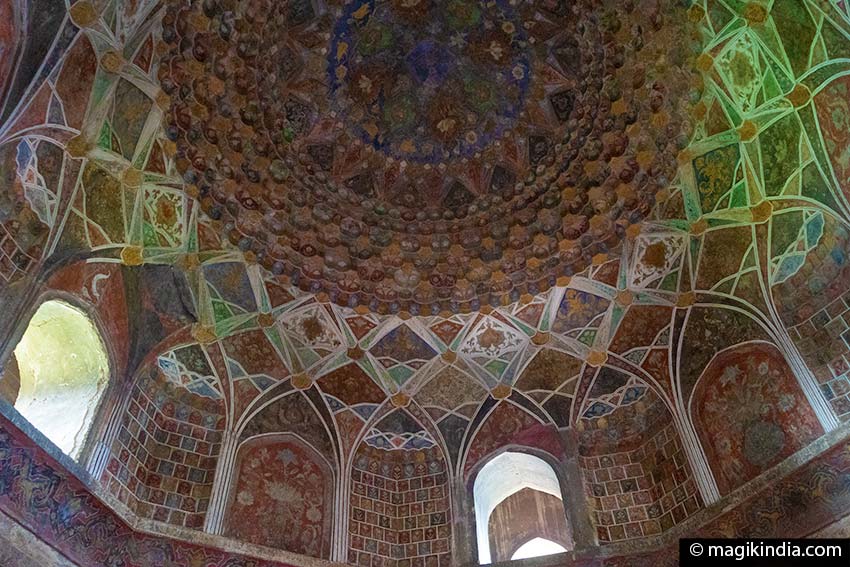


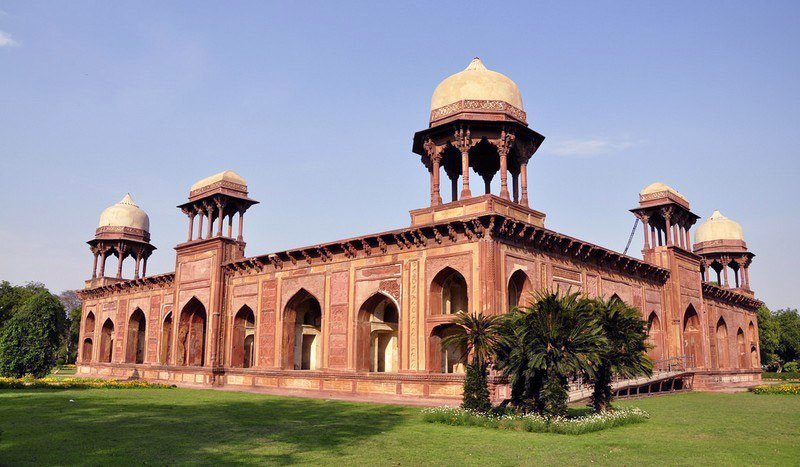
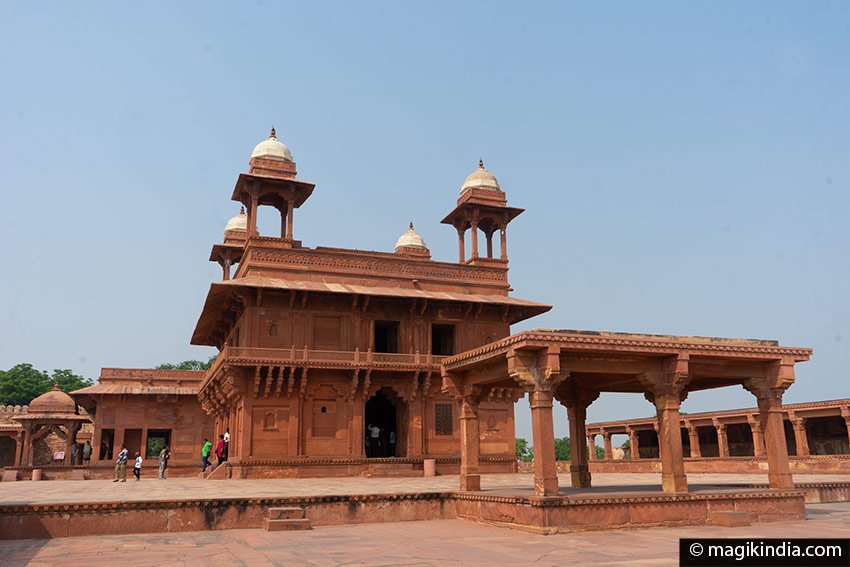

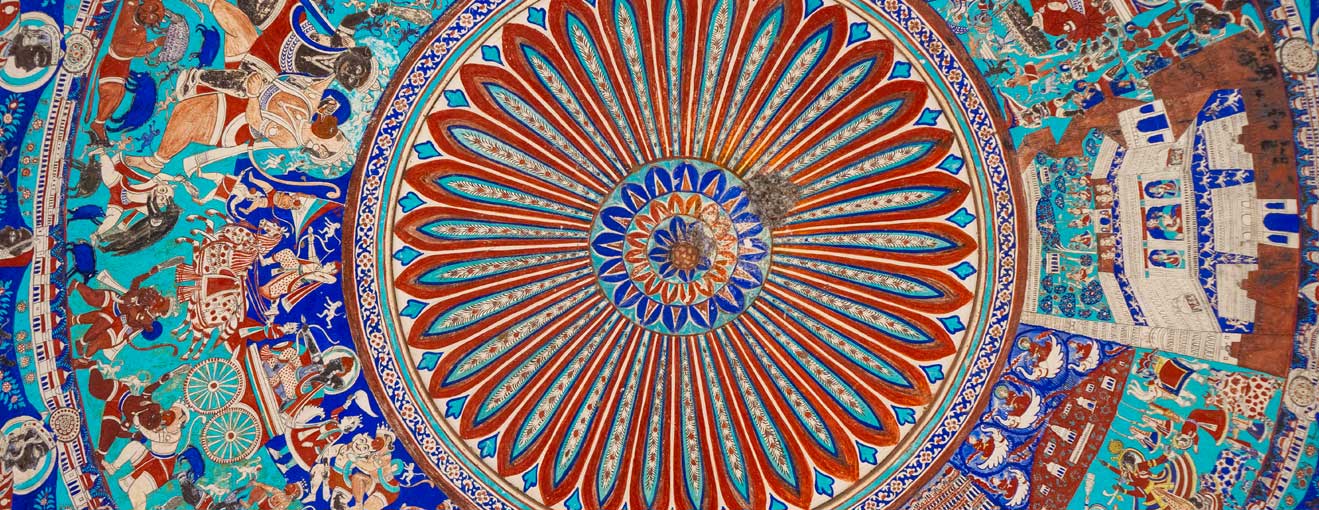


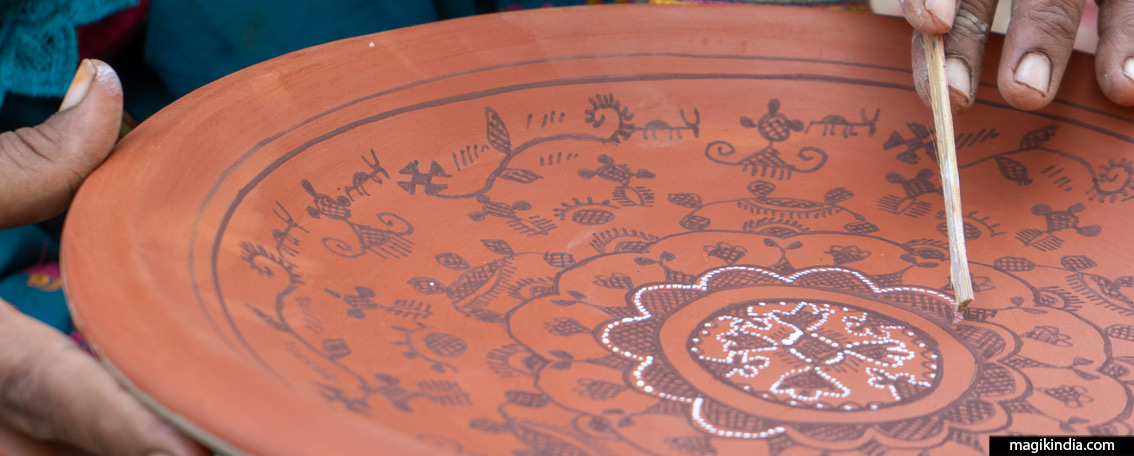
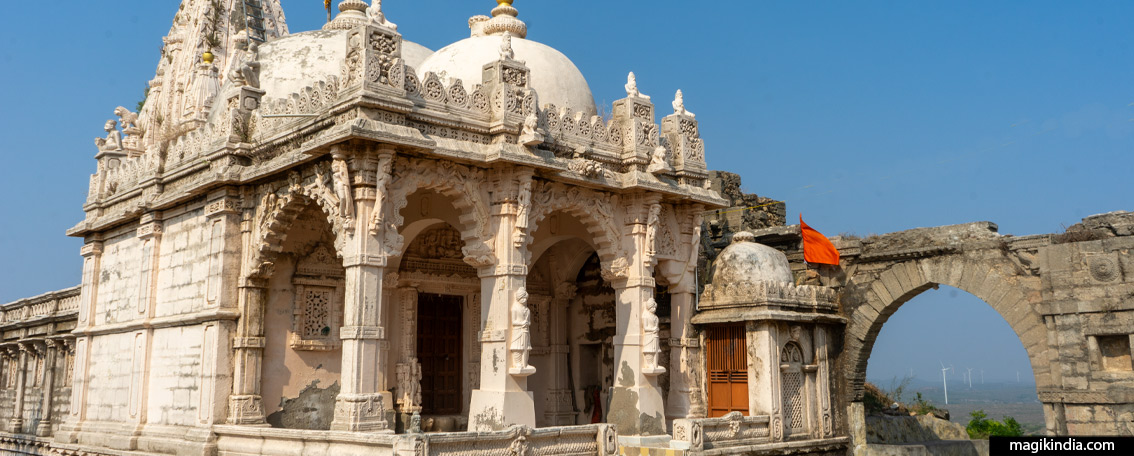
Interesting and informative article all are awesome places. Thanks for sharing!
Many thanks ! 🙂